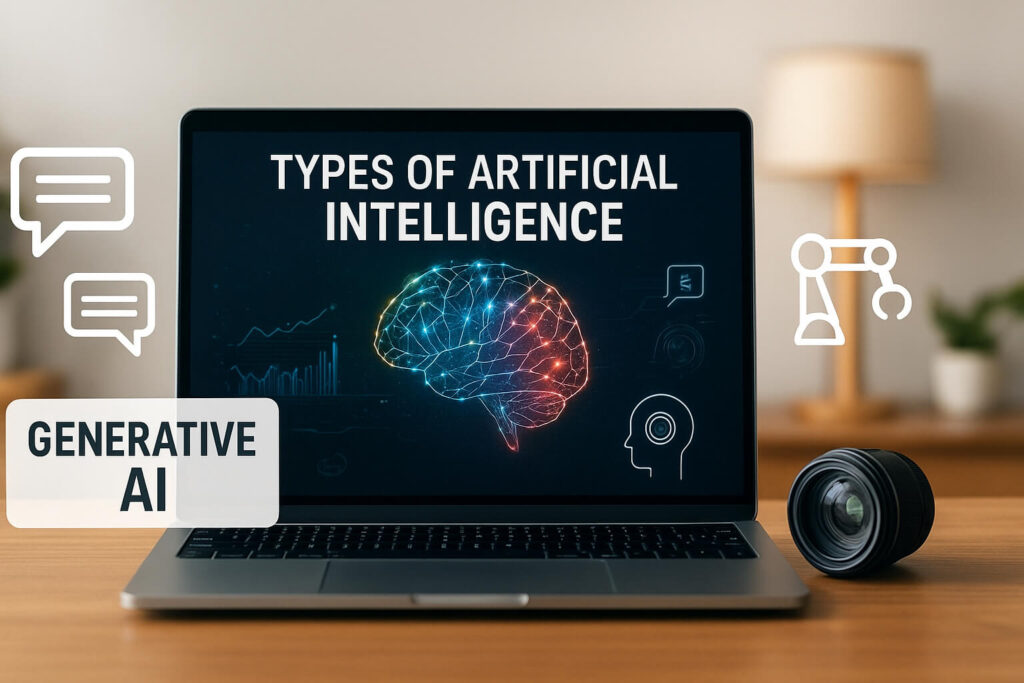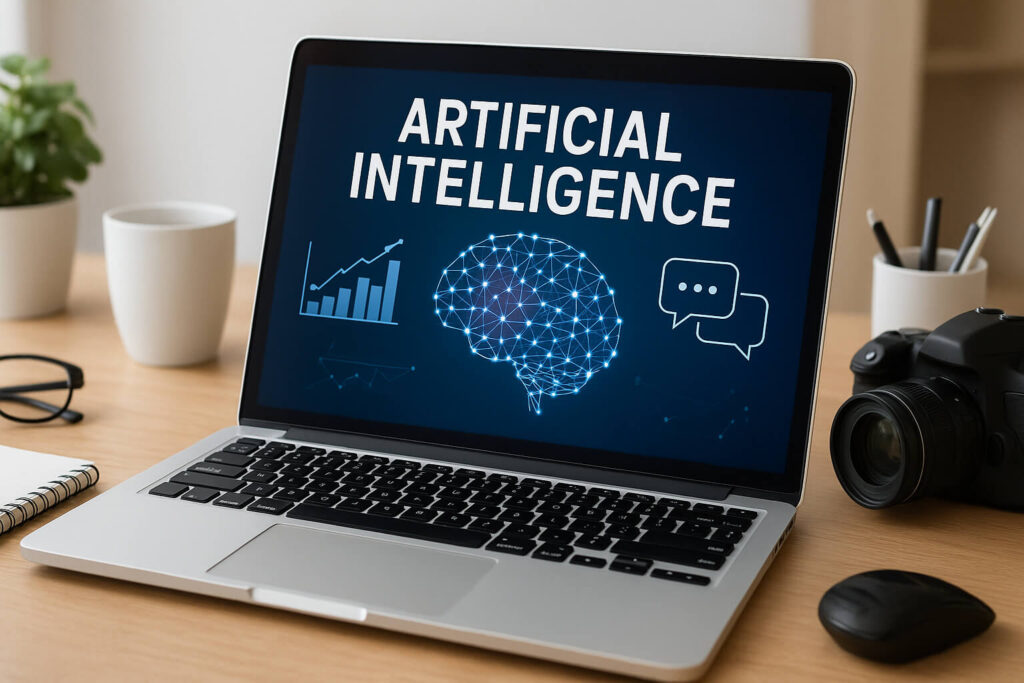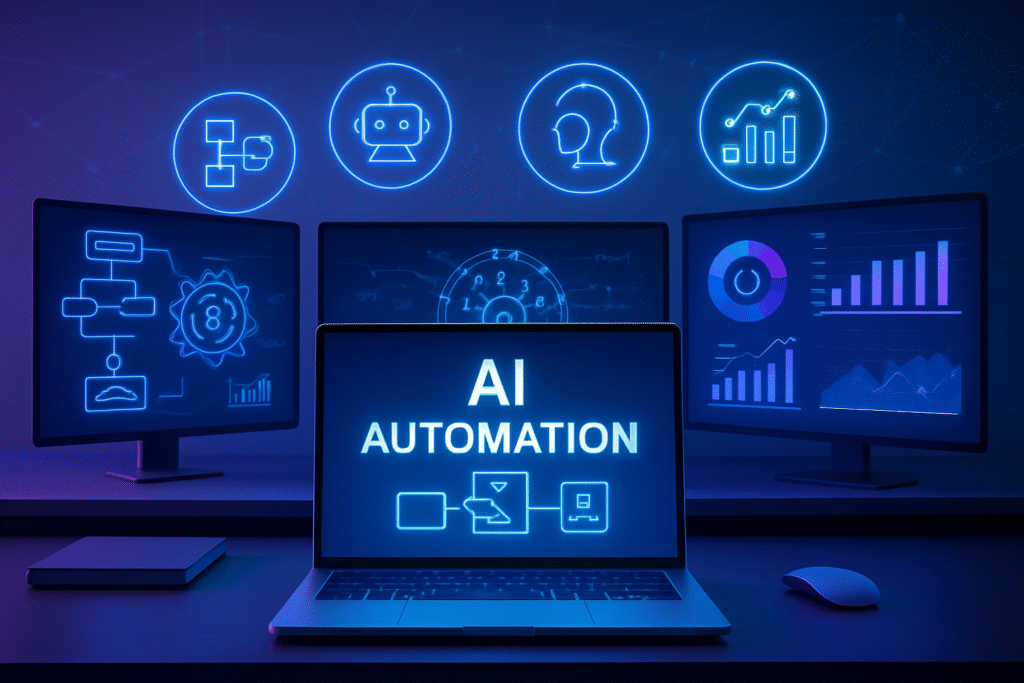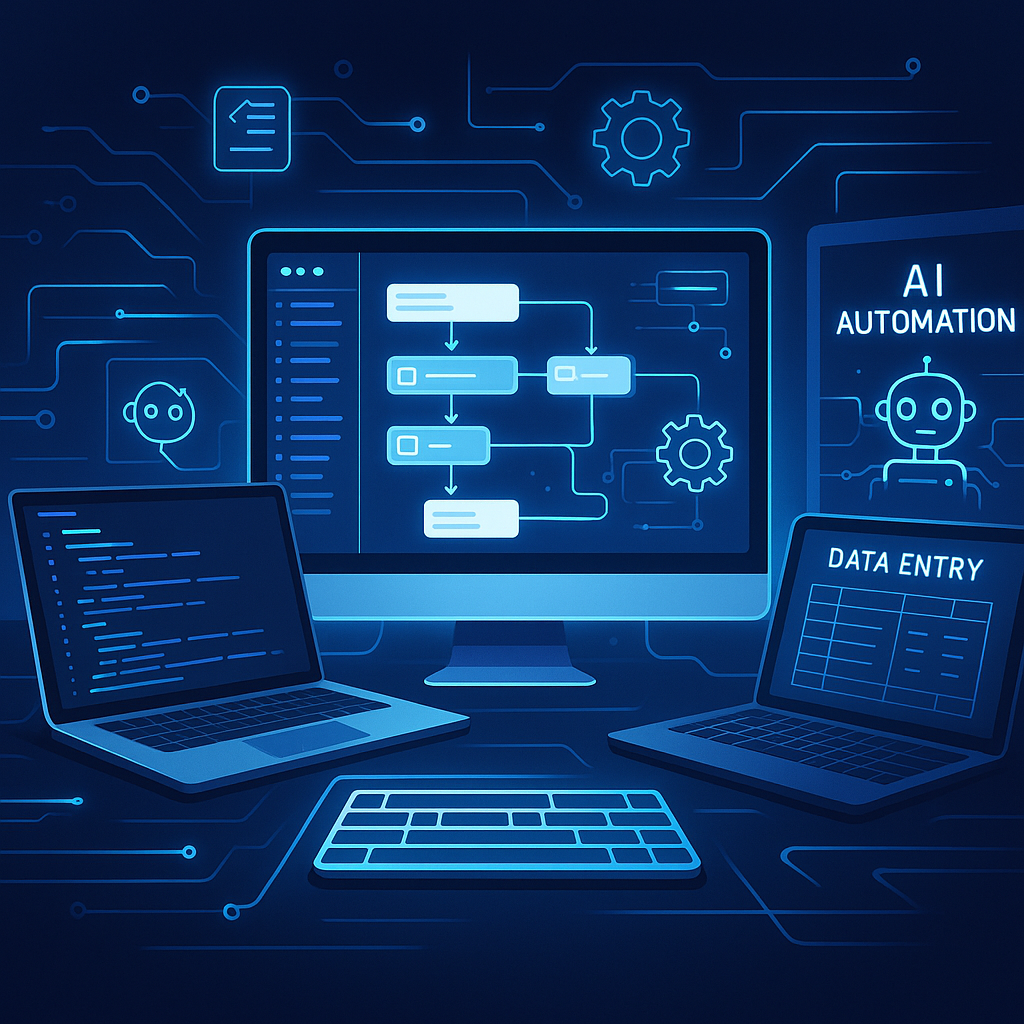Introduction
Types of Artificial Intelligence aren’t just buzzwords anymore—they’re reshaping how we live, work, and connect. AI has stepped out of research labs and into our pockets, powering the apps we can’t live without and the tools that make life easier.
Your phone unlocks with a glance. Your voice assistant knows exactly what song you want. Your shopping app suggests items you actually need. That’s AI working behind the scenes, quietly making everything smoother.
The field might seem overwhelming, but each branch has a clear purpose. Generative AI dreams up fresh content—text, images, even entire songs. Natural Language Processing (NLP) helps machines chat like humans. Computer Vision gives systems the power to see and understand what they’re looking at. AI speech technology turns your voice into text and text back into voice, completely changing how we talk to our devices. Data-driven AI digs through mountains of information to find the insights that drive smarter decisions.
Why should you care? Because these types of artificial intelligence aren’t stuck in textbooks—they’re actively making your work faster, you’re learning quicker, and your daily tasks effortless. Every email you write, every online purchase you make, every personalized video you watch has AI fingerprints all over it.
This guide breaks down each branch in easy-to-understand language. You’ll walk away knowing how these technologies connect, why they matter right now, and where they’re headed next.
What Are the Main Types of Artificial Intelligence?
Artificial Intelligence means machines that can learn, think, and act in ways that feel surprisingly human. At its core, AI takes data and algorithms and uses them to solve problems, spot patterns, and make decisions. But here’s the thing—not all AI is created equal.
We typically break AI down into three main categories.
First up is Narrow AI (also called Weak AI). This is the specialist—it handles one specific task incredibly well. Think movie recommendations or face recognition. Most AI systems you interact with today fall into this category, from chatbots to spam filters.
Then there’s General AI. This is the dream scenario where AI can understand, learn, and tackle any problem across multiple fields. Imagine an AI that could write poetry, solve math problems, and diagnose diseases with equal skill. We’re not there yet, but that’s the goal.
Finally, there’s Super AI—the stuff of science fiction where machines surpass human intelligence entirely. They’d solve problems faster and make decisions beyond our comprehension. For now, this stays firmly in the “what if” category.
Understanding these types of artificial intelligence helps us see where we stand today and how far we have to go before machines truly think like us.
Generative AI: Creativity Powered by Machines
Here’s where things get really exciting. Generative AI doesn’t just follow rules or crunch existing data—it creates something entirely new. Text, images, music, even videos. This creative spark makes generative AI one of the most thrilling types of artificial intelligence we’ve seen.
Text generation has exploded recently. ChatGPT can write essays, answer complex questions, or hold conversations that feel genuinely human. On the visual side, DALL·E creates stunning images from simple written prompts, while MidJourney produces artwork that could hang in galleries. Musicians and filmmakers are diving in too, using AI to craft new sounds and visuals that push creative boundaries.
The business benefits are huge. Companies use generative AI to pump out content—blogs, product descriptions, marketing copy—in minutes instead of hours. Designers can generate quick prototypes without starting from zero. Programmers get instant coding help, with AI suggesting functions or catching bugs on the spot. Time saved, creativity boosted, costs slashed.
Of course, it’s not all smooth sailing. Generative AI can inherit biases from its training data. It might create convincing but completely false information. And then there’s the whole copyright debate: when AI creates something, who actually owns it?
Despite these hurdles, the potential is undeniable. Generative AI brings machine creativity closer to human imagination than ever before. Learn to guide these tools with the right prompts, and you unlock new ways to express ideas, test concepts, and solve problems.
Bottom line: generative AI isn’t replacing human creativity—it’s amplifying it, giving us tools that supercharge imagination and accelerate innovation.
Natural Language Processing (NLP): Teaching Machines to Understand Us
Natural Language Processing (NLP) is the bridge between human communication and machine understanding. It gives computers the ability to read, interpret, and respond to our language just like another person would. Without NLP, talking to AI would feel like programming a calculator. With it, conversations flow naturally.
You’re already using NLP more than you realize. Website chatbots guide you through purchases and answer questions. Translation apps instantly convert text or speech between languages, making the world smaller. Social media platforms scan posts to detect whether they’re positive, negative, or neutral. Email systems filter out spam by recognizing suspicious patterns. Voice assistants like Alexa and Google Assistant rely on NLP to understand what you’re asking and respond naturally.
These everyday uses show why NLP ranks among the most practical types of artificial intelligence. It eliminates the barrier between humans and machines, making technology accessible to everyone. No need to learn coding—just use your natural language.
The impact goes way beyond convenience. Businesses improve customer service, automate support tickets, and analyze thousands of customer reviews instantly. For individuals, NLP saves time and makes technology more inclusive—think of text-to-speech tools helping visually impaired users or real-time captions making video calls accessible.
Sure, NLP faces challenges. Human language is messy—full of slang, sarcasm, and cultural references that machines struggle with. Training data can introduce unfair biases. Context matters hugely: the same word can mean different things depending on tone or situation.
But the progress is remarkable. Today’s NLP systems handle longer, more complex texts, pick up on subtle meanings, and generate responses that feel genuinely personal.
NLP connects human expression with machine power, shaping how we ask questions, learn new things, and communicate in our digital world.
Computer Vision: Helping AI See the World
Computer vision teaches machines to see and understand the world like we do. Instead of just processing numbers, these systems analyze images and videos to identify objects, track movement, and recognize patterns. Think of it as giving machines a pair of eyes—and a brain to make sense of what they see.
It’s everywhere in daily life. Facial recognition unlocks your phone and secures your apps. Self-driving cars use computer vision to spot pedestrians, read traffic signs, and avoid accidents. In hospitals, AI examines X-rays and MRI scans to catch diseases faster than traditional methods. Even grocery stores use vision-powered cameras to monitor shelves and track inventory automatically.
The benefits are massive. Computer vision boosts accuracy in medical diagnosis, increases safety in transportation, and streamlines operations from farming to logistics. It cuts down human error by automating tasks that need constant attention. Businesses save time and money while people get faster, more reliable services.
But there are real risks too. Poorly trained systems might misidentify people or objects, leading to serious mistakes. Privacy concerns grow when cameras collect personal data without clear permission. Bias in training data can cause unfair outcomes, especially in facial recognition across different ethnic groups.
Despite these challenges, the progress is undeniable. Computer vision as one of the key types of artificial intelligence keeps expanding possibilities—smarter cities, better healthcare, safer roads. As the technology improves, machines will see our world with increasing clarity, creating a future where vision-powered AI becomes part of everyday life.
AI Speech and Voice Technologies
AI speech and voice technologies have completely changed how we interact with machines. Instead of typing commands or tapping screens, we simply talk to our devices and they talk right back. This shift makes technology feel more natural and accessible than ever.
Voice assistants lead this revolution. Siri, Alexa, and Google Assistant answer questions, play music, set reminders, and control smart home devices. They’re valuable because speaking is often faster than typing, and hands-free control is perfect when you’re driving, cooking, or have your hands full.
Speech-to-text is another game-changer. Students dictate notes directly to their devices, professionals draft emails by speaking, and doctors record patient information without touching a keyboard. The reverse—text-to-speech—reads articles, books, or instructions aloud. These tools help people with visual impairments, reading difficulties, or busy schedules consume information more effectively.
The impact reaches far beyond convenience. For accessibility, voice AI ensures people with disabilities can use technology independently. For productivity, it saves time by instantly converting spoken thoughts into written text. For communication, it breaks down barriers—real-time translation lets people speaking different languages connect seamlessly.
Challenges remain: some accents trip up the systems, and always-listening devices raise privacy concerns. But improvements happen rapidly, making interactions smoother each year.
AI speech and voice tools are reshaping how we work, learn, and communicate. By making language a two-way conversation, they bring machines closer to human interaction and make AI accessible to more people.

Extracting Data & Insights with AI
Data multiplies every second, and humans simply can’t keep pace. AI steps in to process massive datasets at lightning speed, uncovering patterns and connections that would take humans years to find. By analyzing numbers, text, and images at scale, AI transforms overwhelming information into clear, actionable insights.
Predictive analytics is one major application. Businesses use it to forecast sales, identify market trends, and predict customer behavior. Retailers plan inventory by studying buying patterns, while hospitals anticipate patient needs using historical health data.
Business intelligence is another powerful use. AI dashboards pull data from multiple sources and organize it into real-time updates for decision-makers. Instead of making educated guesses, managers rely on accurate insights to boost efficiency, reduce costs, and discover new growth opportunities.
Fraud detection showcases AI-driven insights in action. Banks and e-commerce platforms use algorithms to scan millions of transactions instantly. The system flags unusual patterns—suspicious logins, fake accounts, or irregular purchases—protecting users before any damage occurs.
Future trends point toward even deeper integration. AI-driven insights will guide personalized education, smarter city planning, and climate change modeling. As these systems grow more sophisticated, their predictions become sharper, helping societies prepare for challenges and adapt to change.
The ability to extract meaningful insights makes AI more than just a tool—it becomes a trusted decision-making partner. By turning overwhelming data into clear guidance, AI helps individuals and organizations act faster, smarter, and with greater confidence.
The Future of Artificial Intelligence: Where Are We Heading?
The future of artificial intelligence points toward systems that combine multiple skills seamlessly. Multimodal AI can read text, analyze images, and process audio all at once, creating richer and more accurate results. Imagine asking one tool to summarize a document, describe a photo, and translate speech—all in a single conversation.
Personal AI represents another exciting trend. These assistants will learn from your individual habits, preferences, and routines. Instead of generic responses, they’ll offer tailored advice—managing your schedule, guiding your study plans, or tracking your health goals based on what matters to you.
But with great power comes great responsibility. Ethics in AI becomes more critical as technology expands its reach. Questions about bias, data privacy, and job displacement need serious attention. Companies and governments must balance rapid innovation with rules that protect fairness and safety for everyone.
The impact will ripple across every industry. Healthcare will deliver faster, more accurate diagnoses. Education will offer truly personalized learning experiences. Businesses will make decisions based on sharper insights. Even creative industries will expand as machines help people generate ideas and test concepts at unprecedented speed.
The future of AI looks incredibly powerful but also complex. By combining breakthrough capabilities with ethical responsibility, the next wave of AI can deliver solutions that benefit not just businesses but entire societies.
Conclusion
The different types of artificial intelligence—Generative AI, NLP, Computer Vision, and more—are fundamentally changing how we live and work. Each branch brings unique strengths: Generative AI sparks creativity, NLP bridges communication gaps, and Computer Vision gives machines sight. Together, these technologies unlock possibilities across every industry, from healthcare and finance to education and entertainment.
We’ve explored the main categories, explained their real-world applications, and shown how they’re already woven into daily life. The goal was straightforward: make complex concepts accessible and demonstrate why AI matters right now.
AI will continue evolving rapidly, and staying informed is your best strategy for benefiting from these advances. Whether you’re curious about how these tools might transform your career or business, keep learning and exploring. Knowledge builds confidence, and confidence creates opportunities.
The AI revolution is just getting started—make sure you’re part of it.
Frequently Asked Questions (FAQs)
1. What are the main types of artificial intelligence?
The main types of artificial intelligence include Generative AI, Natural Language Processing (NLP), Computer Vision, and Expert Systems. Each tackles different challenges. Generative AI creates fresh content. NLP understands human language. Computer Vision analyzes images and videos. Expert Systems provide specialized advice. These branches work together to transform industries and everyday experiences.
2. How does Generative AI differ from traditional AI?
Generative AI creates entirely new content—text, images, or code—while traditional AI follows predetermined rules or analyzes existing data. For example, a generative AI chatbot can craft original answers, not just retrieve pre-written responses. This creative ability makes Generative AI incredibly powerful for writing, design, and problem-solving, offering businesses far more flexibility than rule-based systems.
3. Why is NLP important in artificial intelligence?
NLP (Natural Language Processing) allows machines to understand and respond to human language naturally. It powers chatbots, voice assistants, and translation tools that millions use daily. Without NLP, computers couldn’t interpret meaning in text or speech. Businesses rely on NLP to enhance customer support, automate routine tasks, and analyze feedback quickly. It’s the essential bridge connecting people and machines.
4. What is the role of Computer Vision in AI?
Computer Vision enables AI to interpret and understand images and videos just like humans do. It detects faces, identifies objects, and reads text from pictures. Healthcare uses it to analyze medical scans. Retail applies it for inventory tracking. Security systems use it for surveillance. Computer Vision essentially gives machines “eyes,” making them invaluable for visual tasks across countless industries.
5. Can different types of AI work together?
Absolutely! Many modern systems combine multiple AI types for better results. A smart assistant might use NLP to understand your speech, Computer Vision to process images you share, and Generative AI to craft personalized responses. This integration creates more powerful solutions. Businesses benefit because combined systems improve accuracy, save time, and deliver more sophisticated automation.
6. What industries benefit most from AI today?
AI transforms virtually every industry. Healthcare uses AI for faster diagnosis and treatment planning. Finance relies on AI for fraud detection and risk assessment. Retail applies AI for personalized recommendations and inventory management. Manufacturing uses AI for quality control and predictive maintenance. Education benefits from AI-powered tutoring systems. Marketing improves with AI-driven customer insights. The different types of artificial intelligence impact nearly every sector of the modern economy.
Also read:
Beginner-Friendly: Your First AI Workflow Using Zapier + ChatGPT
How to Debug AI Workflows: Common Errors and Fixes (2025 Guide)



